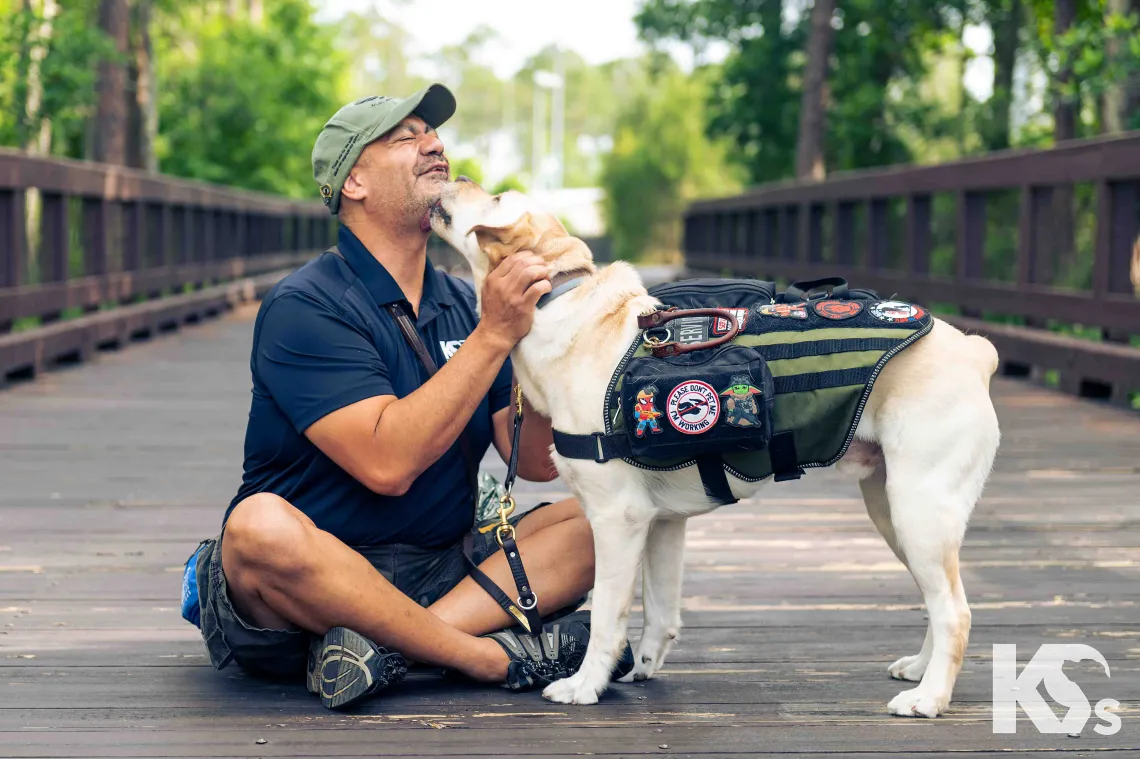Animal-Assisted Intervention
UArizona research reveals the health benefits of human-animal interactions.

A military veteran bonds with a service dog.
K-9 for Warriors
It’s hard not to be happy when we glimpse our favorite wagging tail or hear that familiar purr. But just how much does interacting with pets boost our well-being?
Until recently, science had no hard answers to that question. But the study of the human-pet bond is now growing exponentially, and the University of Arizona is at the forefront of the research. It boasts not only an extensive human-animal interaction faculty group but also one of field’s top experts in Maggie O’Haire, associate dean at the College of Veterinary Medicine.
O’Haire explains that the leading theory for why people find animals soothing is what’s called the “biophilia hypothesis.” According to this theory, because humans evolved with animals in nature, she says, “we have an innate propensity to be attuned to and desire to be around animals and nature, or lifelike things. Although we are not around nature as much as we once were, we still seek it out. Our brains still respond uniquely to sights of animals or nature. In many cases, this can have a calming effect on us, because it is a positive, external focus of attention.”

Kerri Rodriguez, assistant professor at the College of Veterinary Medicine; professor Maggie O'Haire, associate dean for research of the college; and Hendrix
Kevin Doer
Physiologically, this plays out in our hormones, specifically cortisol — which impacts our stress and energy levels — and oxytocin, also known as the “love hormone” for the safe, nurtured way it makes us feel. Learning precisely how animal interactions affect those hormones offers great potential for helping people who’ve experienced trauma, such as combat veterans. To this end, O’Haire’s lab recently secured a $3.2 million grant from the National Institutes of Health to study how service dogs can benefit veterans suffering from PTSD.
Early results are encouraging. Although cortisol helps most of us get moving in the morning, that role is impaired when stress becomes chronic from co
nditions like post-traumatic stress disorder. However, using saliva samples from veterans, O’Haire showed that their morning cortisol levels returned to normal after living with their service dogs. So powerful is this effect that even looking at pictures of animals can reduce anxiety in people.
She also found that if a little pet love helps a bit, lots of that love can have dramatic impacts. Study subjects obviously enjoyed these benefits; tracking devices revealed that the veterans spent more than 80% of each day with their service animals. That level of bonding “is a finding in itself,” she says. “Who else in your life would you willingly choose to spend 20 hours a day with?”
Other discoveries are equally promising. For instance, “in a prior study where we followed service dogs for just three months, we were able to see clinically significant differences in levels of PTSD symptomatology for those veterans who had a service dog,” O’Haire says. The veterans also tracked their moods with a smartphone app, and O’Haire says those with service animals reported more positive emotions, fewer negative emotions, and fewer panic attacks.
Of course, you don’t have to be a veteran to benefit from animal interactions. Other studies from UArizona human-animal interaction researchers have shown that programs where students (or children) interact with animals can greatly reduce school-related and social anxiety within a mere 10 minutes.
Such findings have driven explosive growth in this field, and UArizona continues to lead the way. “We are excited to be creating the world’s largest group of faculty dedicated to this topic,” O’Haire says. “Historically, there have been isolated individuals doing work on the human side alone or on the animal side alone. Here, for the first time, we have a critical mass of experts on both sides working together.”
And both sides will keep their eyes on a common objective. “Our overall goal is to understand the impact of human-animal interaction on human health and animal health, so that we can make a better world for animals and their people,” she says. “As a College of Veterinary Medicine, we hope to equip our future veterinarians with the tools they need to not just help animals but to also help the people in those animals’ lives.”
To support this research, visit give.uafoundation.org/humananimalresearch.
